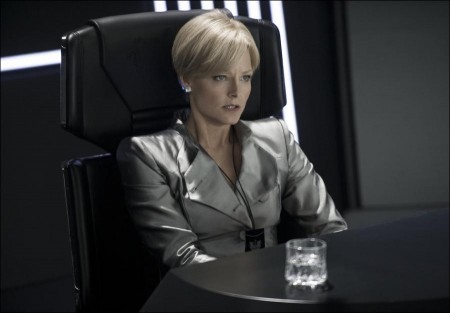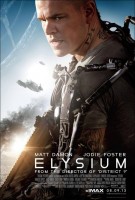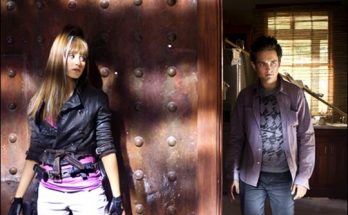In the year 2154, two classes of people exist: the very wealthy, who live on a pristine man-made space station called Elysium, and the rest, who live on an overpopulated, ruined planet. The people of Earth are desperate to escape the crime and poverty that is now rampant throughout the land.
The only man with the chance to bring equality to these worlds is Max (Matt Damon), an ordinary guy in desperate need to get to Elysium. With his life hanging in the balance, he reluctantly takes on a dangerous mission – one that pits him against Elysium’s Secretary Delacourt (Jodie Foster) and her hard-line forces – but if he succeeds, he could save not only his own life, but millions of people on Earth as well.
About the Film (2013)
In 2009, Neill Blomkamp burst onto the scene with his first feature film, District 9. It was an enormous critical and commercial success: critics praised Blomkamp’s filmmaking style, and audiences around the world turned out to the box office to support the film’s originality and innovation. But the reason it resonated was that the movie had themes that grabbed the audience: the way the film seamlessly blended a genre alien-invasion movie with biting and relevant social commentary pleased both moviegoing audiences and members of the Academy of Motion Picture Arts and Sciences, who nominated the movie for Oscars® for Best Picture and Best Adapted Screenplay.
In his film, Elysium, Blomkamp has drawn two distinct and separate worlds: an overpopulated, ruined Earth, and Elysium, a man-made space station for the extremely wealthy. While in 2013, six astronauts live and work on the international space station orbiting about 250 miles above the surface of the Earth, 150 years from now, in Blomkamp’s vision, those humble beginnings will expand to become a home with the best of everything for the rich. “The idea, in a way, is ludicrous,” says Blomkamp. “The idea of taking up stone, and mortar, and concrete, and swimming pools – and everything you’d need to build these mansions in a space station – is satire. It just reinforces the central idea of the film – the people of Elysium have unimaginable wealth, and they use those resources to build a separate, synthetic, almost hermetic environment for themselves. In that way, Elysium is the reverse of an alien-invasion story – it’s still about human beings trying to protect a way of life, but instead of fighting for Earth, they do it by going into space.”
Blomkamp based his ideas for a perfect world apart from a desperate, ruined Earth on real-life concepts. “Back in the ‘70s, people were actually discussing the idea of leaving Earth and building space stations for us to potentially live on one day. One of the top answers to that challenge was the Stanford Torus. I like the idea of taking this well-known concept and caking it with wealth, diamonds and Bel Air-style mansions – the idea, the image, of putting these exorbitant, ridiculous mansions on a doughnut-shaped space station is hilarious to me, and it becomes something I want to make a movie about.”
Simon Kinberg, who produces the film with Blomkamp and Bill Block, says that the non-stop action of Elysium and the political subtext of the film mesh well together, because both come out of who Blomkamp is as a writer and director. “First and foremost, Elysium is an action movie, but the thing about Neill is that he happens to be very interested in the world and politics,” he says. “There are themes in the movie that you wouldn’t expect from a summer action movie, but hopefully, a moviegoer can see the movie and enjoy the action experience, but have something seep in about the real world as well.”
“Neill has the gravitas and expertise as a filmmaker to deliver a crackling action thriller that also tackles serious themes and subjects,” adds Block, the CEO of QED International, which also produced District 9. “After our experience with Neill on District 9, we were thrilled to do this one with Modi Wiczyk and MRC.”
“I want to blow things up as much as I want to make films that are about serious topics,” Blomkamp says. “I’m more of a visual artist than anything else. I don’t want to make movies that are too serious – I like action and visual imagery, and that’s where it starts for me. But I’m also interested in politics, so once I’ve set up the world and start getting into character and story, the political ideas that intrigue me work their way in there. The subjects that interest me tend to be large, sociological concepts, and I like the idea of making films about those concepts in ways that aren’t heavy-handed or preachy – I hope that putting these topics in this setting will let the audience look at them from a different perspective. The most important thing to me is that the movie is entertaining, but I like to put a worthwhile story underneath, so it isn’t just pure popcorn.”
“I like to think it’s a hopeful message,” says Matt Damon, who takes on the lead role of the film. “Even in a future where it’s every man for himself, it’ll be possible for a human being to hold on to his humanity.”
Just as District 9 explored ideas of social justice, class separation, and race relations, Elysium asks important questions about where we are now in a context of where we are going. “The entire film is an allegory,” Blomkamp says. “I tend to think a lot about the topic of wealth discrepancy and how that affects immigration, and I think the further we go down the path that we are on, the more the world will represent the one in Elysium. In that sense, I think the questions that underlie the film are quite accurate.”
In fact, Blomkamp says that the heart of the conflict is more real than one might realize. “When people see the wealth of Elysium back-to-back with the poverty of Earth, I think some will think that it’s more extreme than reality – and it is not. The two things exist, on Earth, right now,” he says. “In Mexico City, in Johannesburg, in Rio, you have pockets of great wealth, gated communities, amidst a sea of poverty. And I think that’s where the cities of the US are going to end up, too – that’s why the movie is set in Los Angeles. But that disparity can’t last.And I don’t know what we’re going to get – whether we’re going to pull ourselves forward or self-implode. Elysium is the fork in the road.”
About the Production (2013)
To portray the world of Elysium, it was necessary to draw two very distinct and different worlds – with two locations and two styles of shooting. “Contrast was a huge part of making this film, because we wanted to show Earth and Elysium back to back,” says Blomkamp. “So, to maintain that very distinct, black-and-white partition between the two places, we thought about every single element of the filmmaking process being separate.”
Production Designer Philip Ivey’s main goal in designing the film was to play upon the contrast been the haves on Elysium and the have-nots on Earth. “The idea is that all of the money is on Elysium,” says Ivey. “But even though Earth has to feel gritty and real to the audience, so do the clean surfaces on Elysium. We have robots trimming the hedges; everything is heavily manicured. It is all made from the finest materials.”
The film was primarily shot in two locations: Mexico City, which doubles for Los Angeles in 2154, and Vancouver, which doubles for Elysium. “Neill’s aesthetic sensibility is about making things real, and that comes through both in the locations and the action,” says Kinberg. One of the other aspects of District 9 that captured audiences and critics was that at times, the film felt real – dramatic scenes, mockumentary footage, and real news video were all part of the same story. Kinberg says that Blomkamp brings the same sensibility to Elysium. “The sun is real, the smoke is real, the smell is real. The chaos, struggle, and danger of the city informs and infects the movie. Physical action feels gritty and real.”
Filming in Mexico – especially in some of the poorest parts of the country – the irony was not lost on the cast or crew. “As we were filming, I couldn’t help but feel that we are living in our own private Elysium – our own version of this story,” says William Fichtner. “The fact that the people of Elysium want to keep their perfect place for themselves, well, that’s not unlike our circumstances today.”
Another way that Fichtner’s character is shown as living in literally a different world from the residents of Earth is in his vehicle – represented by one of the world’s most exclusive brands. “We approached Bugatti to see what they would come up with if they were designing a shuttle between Earth and Elysium,” says Cameron Waldbauer, the film’s Special Effects Coordinator. “In two days, they turned around a bunch of illustrations – Neill picked one that he really liked, we 3D modeled it, and then we made it, out of foam and fiberglass.” The shuttle even has the Bugatti badge.
For the design of Elysium, the filmmakers went in the opposite direction. Even though the rich of Elysium can afford the best of everything, “Money doesn’t necessarily buy taste,” Ivey notes. “You have your faux Tuscan mansions, your Malibu modern, the ultramodern houses. And out the windows, thanks to the visual effects, you see the other side of the Torus and spacecraft flying through.”
For certain set concepts on Elysium, the filmmakers called upon the legendary futurist designer Syd Mead (Blade Runner, Tron, Aliens). “It was an honor to have met him and worked with him,” says Ivey. “He did a number of concept illustrations of the torus for us very early on. Later, as the project progressed, Syd’s main contributions were in the overall geometry of the control room and the briefing room. Those are two of my favorite sets in the film.”
The stunts were overseen by Mike Mitchell, the film’s stunt coordinator. “For me, the process began by jumping around in Neill’s office, moving his couches and grabbing glasses and pretending they’re props,” he says. “From that moment, Neill and I started clicking.”
For Mitchell, working with Matt Damon was working with a natural. “He has an exceptional ability to remember movement,” says Mitchell. “He speaks our language. I’m sure he’s been greatly tuned by his work on the Bourne films – but it’s crazy. You can show him six or seven moves in a fight, and then you’ll go to lunch, come back and he’ll say, ‘OK, that was a left, a slip, a right, and that elbow?’ I’d look at Shaun Beaton, Matt’s stunt double, and go ‘OK.’ We don’t remember, but he does.”
About the Special and Visual Effects (2013)
Elysium marks a hybrid between the special and visual effects – capturing in camera what could be physically built and in the computer what could not, and, in some cases, blending the two techniques.
“Neill wants to make a movie that people haven’t seen before,” says Visual Effects Supervisor Peter Muyzers. “Every director does that to one extent or another, but Neill takes it to another level. He creates the story, develops it, and gives them an experience unlike any other out there.”
Blomkamp began by giving strong direction on the look of the droids and the weaponry to the artists at WETA Workshop, who also designed the aliens and weaponry on District 9. They would also design the “HULC suit” – the biomechanical exoskeleton that Max wears and gives him superhuman abilities, even as he is dying.
“It was my favorite prop in the movie,” says Special Makeup FX / Costume / Props Supervisor Joe Dunckley. “When we first got the brief from Neill, it was difficult to imagine how we were going to execute it. In the end, it came off great.”
According to Dunckley, the HULC suit required eight months of research and development and 75 revisions before the design was finalized. In the end, the actor wearing the suit was impressed. “The big thing was mobility,” says Damon. “Elysium is a real action movie, with running and jumping and climbing and fighting, so they wanted to make sure that I could actually move in the suit, and the guys at WETA knocked that out completely. I had 100% mobility. Everything looked metal, but it was super-lightweight, just 25 pounds, distributed all over my body. I could stay in it all day and I’d feel totally fine.”
There are several different kinds of droids populating the world of Elysium – police officers, military, government, medical – and though most would be completed by the visual effects artists at Image Engine (which also created the aliens of District 9), the design process began at WETA Workshop. “The process of designing the droids was very similar to what we did on District 9,” says Dunckley. “Neill wanted them to have a similar size and proportion to humans, but a much sleeker look.”
And that humanoid, bi-pedal form was no accident. “We had to make sure that the design allowed us to cover up the actors,” says Dunckley. Indeed, during production, the roles of the droids were played by stuntmen in gray suits and painted out later, in the computer, by the VFX artists.
“The most important aspect of creating the performance of the droids was making sure that Neill could direct that performance on set with the gray suit actors to achieve a realistic interaction with the cast and environment,” says Muyzers. “Then we could replace that actor with a droid in postproduction and maintain that performance all the way through. We didn’t use motion capture, but the animators were able to directly translate all of the nuances of the droid’s actions frame by frame in exactly the way Neill wanted it.”
Muyzers re-teams with Blomkamp after collaborating with the director on District 9. “District 9 was fairly straightforward – we had a real environment, and we put characters into that environment as realistically as we could,” he says. “On Elysium, it was almost the other way around – Neill wanted to create a world that didn’t exist, but had to look absolutely believable. We created the environment into which we inserted live-action characters. Because of what Elysium is – the home of the very rich – we did lots of research. Neill provided us with images and video of Beverly Hills and Hollywood and the luxury lifestyle. We coordinated closely with Phil Ivey, the production designer, to determine the size of the ring, the width of the ring, how many people could live on Elysium, and how many houses would there be, what do these houses look like, what kind of infrastructure would there be and then obviously, how you get to Elysium. We ended up with a ring three kilometers wide, with a diameter of sixty kilometers – that translates to about a half-million people, living on this space station.”
The most challenging visual effect, says Muyzers, are the establishing shots of Elysium. “It had to be a design, a torus, that you could see in the sky when you’re on Earth. Even when you’re far away, it has to be recognizable as a ring, like you’re holding your wedding band up to the sky,” he says.
Elysium (2013)
Directed by: Neill Blomkamp
Starring: Matt Damon, Jodie Foster, Alice Braga, Sharlto Copley, Diego Luna, Emma Tremblay
Screenplay by: Neill Blomkamp
Production Design by: Philip Ivey
Cinematography by: Trent Opaloch
Film Editing by: Julian Clarke, Lee Smith
Costume Design by: April Ferry
Set Decoration by: Peter Lando
Music by: Ryan Amon
MPAA Rating: R for strong bloody violence and language throughout.
Studio: Sony Pictures
Release Date: August 9, 2013
Visits: 109






